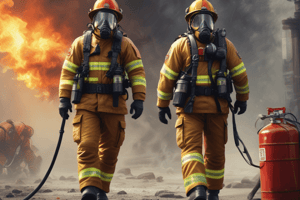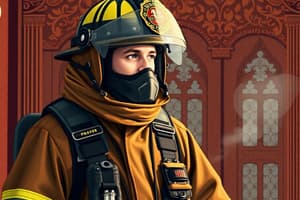Podcast
Questions and Answers
When is it necessary to wear Structural Firefighting Gloves?
When is it necessary to wear Structural Firefighting Gloves?
- During firefighting, overhaul, training, and when using hand or power tools (correct)
- When wearing the SCBA face piece
- Only during overhaul and training operations
- Only when fighting trash fires and grass fires
What is the rule about Extrication gloves in structural firefighting operations?
What is the rule about Extrication gloves in structural firefighting operations?
- They are recommended but not required
- They are only worn during overhaul operations
- They will not be worn during structural firefighting operations (correct)
- They must be worn at all times
When must the chinstrap of the helmet be in the down position?
When must the chinstrap of the helmet be in the down position?
- When operating near moving vehicles
- Only when working above the head
- When the helmet is worn, the chinstrap will be in the down position under the chin (correct)
- Only when the possibility of foreign particles or objects may come in contact with the eyes
What happens to protective clothing after potential exposure during structural firefighting operations?
What happens to protective clothing after potential exposure during structural firefighting operations?
Why should firefighters refrain from wearing firefighting protective clothing during routine daily activities?
Why should firefighters refrain from wearing firefighting protective clothing during routine daily activities?
When is it necessary to wear full protective clothing during rescue operations?
When is it necessary to wear full protective clothing during rescue operations?
When do firefighters wear helmets?
When do firefighters wear helmets?
When are eye shields, eye shields or goggles required to be worn?
When are eye shields, eye shields or goggles required to be worn?
What is the primary objective of the guideline regarding firefighter protective clothing?
What is the primary objective of the guideline regarding firefighter protective clothing?
According to the guideline, when are helmets not required for personnel?
According to the guideline, when are helmets not required for personnel?
Which of the following scenarios would NOT necessitate the use of full protective clothing according to the guideline?
Which of the following scenarios would NOT necessitate the use of full protective clothing according to the guideline?
What is the guideline's stance on wearing hearing protectors when riding in jump seats?
What is the guideline's stance on wearing hearing protectors when riding in jump seats?
Based on the guideline, who has the authority to decide whether turnout coats and Nomex hoods are required during overhaul operations?
Based on the guideline, who has the authority to decide whether turnout coats and Nomex hoods are required during overhaul operations?
Which of the following actions would be considered a violation of the guideline's purpose?
Which of the following actions would be considered a violation of the guideline's purpose?
Based on the information provided, what can be inferred about the guideline's approach to safety?
Based on the information provided, what can be inferred about the guideline's approach to safety?
Which of the following statements best reflects the guideline's emphasis on the use of Nomex hoods?
Which of the following statements best reflects the guideline's emphasis on the use of Nomex hoods?
Flashcards are hidden until you start studying
Study Notes
Protective Clothing Guidelines
- The purpose of this guideline is to ensure the safety of fire department personnel operating in hazardous environments or hazard zones by establishing the proper use of firefighter protective clothing.
Helmet Usage
- Helmets are not required for personnel when riding in a closed cab or fully enclosed jump seats on apparatus.
- Helmets shall be worn when operating near moving vehicles, such as EMS incidents on state and county highways, tollway and Village streets.
- When the helmet is worn, the chinstrap will be in the down position under the chin.
Hearing Protection
- Hearing protectors will be worn at all times when personnel ride in jump seats.
Nomex Hood Usage
- The Nomex hood shall be worn when engaged in firefighting or accident scenes, and any other situation where injuries to head and face are likely to occur.
- The use of turnout coats and Nomex hoods during overhaul operations will be at the discretion of Command.
Face and Eye Protection
- The face shield, eye shield or goggles shall be utilized at any time the need for eye protection seems apparent, such as during overhaul, when operating hand or power tools, and when fighting trash fires, grass fires and any other fires where the SCBA face piece is not being worn.
- The face shield, eye shield or goggles will be in the down position whenever working above the head and whenever the possibility of foreign particles or objects may come in contact with the eyes.
Glove Usage
- Structural Firefighting Gloves shall be worn when engaged in firefighting, overhaul, training, or when using hand or power tools, and any other situation where injuries to the hand are likely to occur.
- Extrication gloves will not be worn during structural firefighting operations.
Protective Clothing Maintenance
- Protective clothing may become soiled and/or exposed to potentially contaminating by-products during structural firefighting operations.
- Protective clothing shall be properly laundered after any potential exposure.
- Firefighters should refrain from wearing firefighting protective clothing when in contact with the public, i.e. during routine daily activities such as shopping, public education or ambulance/EMS calls where protective clothing would not be required.
Rescue Operations
- All members shall wear full protective clothing to afford complete personal protection while operating at rescue incidents.
Studying That Suits You
Use AI to generate personalized quizzes and flashcards to suit your learning preferences.




